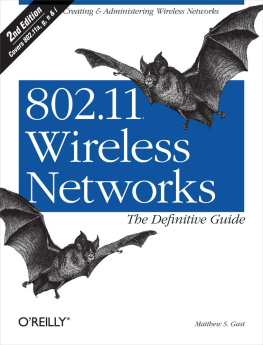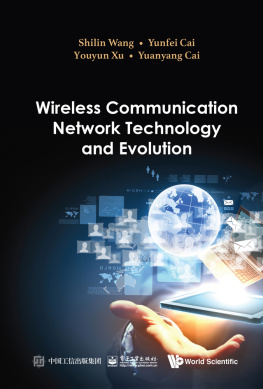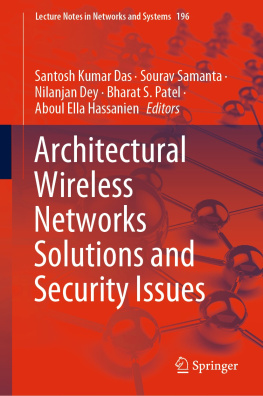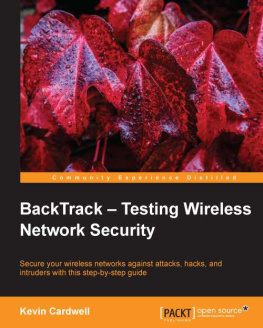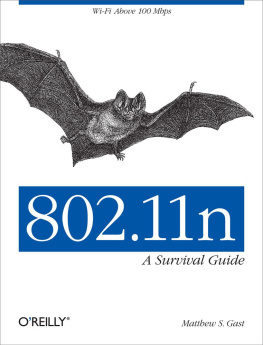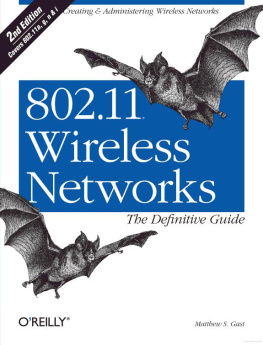Gast - 802.11 Wireless Networks
Here you can read online Gast - 802.11 Wireless Networks full text of the book (entire story) in english for free. Download pdf and epub, get meaning, cover and reviews about this ebook. year: 2009, publisher: OReilly Media, genre: Romance novel. Description of the work, (preface) as well as reviews are available. Best literature library LitArk.com created for fans of good reading and offers a wide selection of genres:
Romance novel
Science fiction
Adventure
Detective
Science
History
Home and family
Prose
Art
Politics
Computer
Non-fiction
Religion
Business
Children
Humor
Choose a favorite category and find really read worthwhile books. Enjoy immersion in the world of imagination, feel the emotions of the characters or learn something new for yourself, make an fascinating discovery.
- Book:802.11 Wireless Networks
- Author:
- Publisher:OReilly Media
- Genre:
- Year:2009
- Rating:5 / 5
- Favourites:Add to favourites
- Your mark:
- 100
- 1
- 2
- 3
- 4
- 5
802.11 Wireless Networks: summary, description and annotation
We offer to read an annotation, description, summary or preface (depends on what the author of the book "802.11 Wireless Networks" wrote himself). If you haven't found the necessary information about the book — write in the comments, we will try to find it.
If you want to deploy your own wireless network--at home or at the office you must first understand the capabilities and risks associated with the 802.11 protocols. And 802.11 Wireless Networks: The Definitive Guide, 2nd Edition is the perfect place to start. This updated edition covers everything you need to know about integrating wireless technology into your current infrastructure.
Gast: author's other books
Who wrote 802.11 Wireless Networks? Find out the surname, the name of the author of the book and a list of all author's works by series.
802.11 Wireless Networks — read online for free the complete book (whole text) full work
Below is the text of the book, divided by pages. System saving the place of the last page read, allows you to conveniently read the book "802.11 Wireless Networks" online for free, without having to search again every time where you left off. Put a bookmark, and you can go to the page where you finished reading at any time.
Font size:
Interval:
Bookmark:

Beijing Cambridge Farnham Kln Sebastopol Tokyo
If you purchased this ebook directly from oreilly.com, you have the following benefits:
DRM-free ebooksuse your ebooks across devices without restrictions or limitations
Multiple formatsuse on your laptop, tablet, or phone
Lifetime access, with free updates
Dropbox syncingyour files, anywhere
If you purchased this ebook from another retailer, you can upgrade your ebook to take advantage of all these benefits for just $4.99. to access your ebook upgrade.
Please note that upgrade offers are not available from sample content.
Matthew Gast was my mentor long before I met him. I began reporting on wireless data networking in October 2000 when I discovered that Apples claims for its 802.11b-based AirPort Base Station were actually true.
Id been burned with another form of wireless networking that used infrared, and had spent many fruitless hours using other interesting networking technologies that led to dead ends. I figured 802.11b was just another one. Was I glad I was wrong!
This discovery took me down a path that led, inexorably, to the first edition of 802.11 Wireless Networks . How did this stuff actually work as advertised? I knew plenty about the ISO model, TCP/IP, and Ethernet frames, but I couldnt reconcile a medium in which all parties talked in the same space with what I knew about Ethernets methods of coping with shared contention.
Matthew taught me through words and figures that I didnt originally understand, but returned to again and again as I descended further into technical detail in my attempts to explain Wi-Fi to a broader and broader audience through articles in The New York Times , The Seattle Times , PC World , and my own Wi-Fi Networking News (http://www.wifinetnews.com) site over the last five years.
I starting learning acronyms from 802.11 Wireless Networks and used Matthews book to go beyond expanding WDS into Wireless Distribution System into understanding precisely how two access points could exchange data with each other through a built-in 802.11 mechanism that allowed four parties to a packets transit.
Now as time went by and the 802.11 family grew and became baroque, the first edition of this title started feeling a little out of datealthough it remained surprising how many new innovations were firmly rooted in developments of the early to mid-1990s. The alphabet soup of the first edition was gruel compared to the mulligatawny of 2005.
Matthew filled the gap between the book and contemporary wireless reality through his ongoing writing at OReillys Wireless DevCenter, which I read avidly. And somewhere in there I was introduced to Matthew at a Wi-Fi Planet conference. We hit it off immediately: I started pestering him for details about 802.1X, if I remember correctly, and he wanted to talk about books and business. (I wound up writing two editions of a general market Wi-Fi book, neither of which did nearly as well as Matthews extraordinarily technical one.)
Since then, I have been in the rare and privileged position to be the recipient of Matthews generosity with his knowledge and humble insight. Matthew isnt one who assumes; he researches. His natural curiosity compels him to dig until he gets an answer thats technically and logically consistent.
Take, for instance, the incredibly political and complicated evolution of the 802.1X standard. (I know, from Matthew, that its properly capitalized since its a freestanding standard not reliant on other specifications. Even the IEEE makes this mistake, and its their rule for capitalization that were both following.)
802.1X is simple enough in its use of the Extensible Authentication Protocol, a generic method of passing messages among parties to authentication. But the ways in which EAP is secured are, quite frankly, insanereflecting Microsoft and Ciscos parallel but conflicting attempts to control support of legacy protocols in a way that only damages easy access to its higher level of security.
Matthew eschewed the religious debate and spelled out the various methods, difficulties, and interoperability issues in an OReilly Network article thats the nugget of the expanded coverage in this book. I defy any reader to find as cogent and exhaustive an explanation before this book was published. Theres nothing as clear, comprehensive, and unaffected by market politics.
At times, Matthew bemoaned the delays that led to the gap between editions of this book, due partly to his joining a startup wireless LAN switch company, but I think readers are better served through his very hard-won, late-night, long-hours knowledge.
Matthews relationship with 802.11 might have previously been considered that of a handy man who knew his way around the infrastructure of his house. If a toilet was running, he could replace a valve. If the living room needed new outlets, he could research the process and wire them in.
But Matthews new job took him allegorically from a weekend household warrior to a jack-of-all-tradesman. Matthew can tear out those inner walls, reframe, plumb, and wire them, all the while bitching about the local building code.
Its been a pleasure knowing Matthew, and its even more a pleasure to introduce you to his book, and let you all in on what I and others have been more private recipients of for the last few years.
Glenn Fleishman
Seattle, Washington
February 2005
People move. Networks dont.
More than anything else, these two statements can explain the explosion of wireless LAN hardware. In just a few years, wireless LANs have grown from a high-priced, alpha-geek curiosity to mainstream technology.
By removing the network port from the equation, wireless networks separate user connectivity from a direct physical location at the end of a cord. To abstract the user location from the network, however, requires a great deal of protocol engineering. For users to have location-independent services, the network must become much more aware of their location.
This book has been written on more airplanes, in more airports, and on more trains than I care to count. Much of the research involved in distilling evolving network technology into a book depends on Internet access. It is safe to say that without ubiquitous network access, the arrival of this book would have been much delayed.
The advantages of wireless networks has made them a fast-growing multibillion dollar equipment market. Wireless LANs are now a fixture on the networking landscape, which means you need to learn to deal with them.
Wireless networks offer several advantages over fixed (or wired) networks:
Users move, but data is usually stored centrally, enabling users to access data while they are in motion can lead to large productivity gains. Networks are built because they offer valuable services to users. In the past, network designers have focused on working with network ports because that is what typically maps to a user. With wireless, there are no ports, and the network can be designed around user identity.
Ease and speed of deploymentMany areas are difficult to wire for traditional wired LANs. Older buildings are often a problem; running cable through the walls of an older stone building to which the blueprints have been lost can be a challenge. In many places, historic preservation laws make it difficult to carry out new LAN installations in older buildings. Even in modern facilities, contracting for cable installation can be expensive and time-consuming.
Font size:
Interval:
Bookmark:
Similar books «802.11 Wireless Networks»
Look at similar books to 802.11 Wireless Networks. We have selected literature similar in name and meaning in the hope of providing readers with more options to find new, interesting, not yet read works.
Discussion, reviews of the book 802.11 Wireless Networks and just readers' own opinions. Leave your comments, write what you think about the work, its meaning or the main characters. Specify what exactly you liked and what you didn't like, and why you think so.

